Talk to enough folks who are passionate about self-reliance and you'll stumble into a wealth of strategies on how to endure should the day-to-day systems we lean on vanish. Some swear by hoarding essentials—think provisions and hydration—anticipating the day when convenience becomes chaos. Then there are the stealthy few who suggest stashing supplies in multiple hideouts, always staying a step ahead of troublemakers or dodging temporary danger zones. You'll find voices in the crowd who champion farming with your own hands as the ticket to survival, urging a return to the land. And inevitably, there's the rugged loner who plans to channel their inner woodsman, a rifle at the ready, confident they'll thrive indefinitely, or at least until order is restored by employing primitive wilderness survival skills.
Yet, none of these approaches are foolproof. Reality tends to laugh at our best-laid plans. A quick glance back at 2020 shows us just how delicate our interconnected world is, and how the most meticulous schemes can falter. What would we do if we hit rock bottom, stripped of our stashes and modern tools? What does starting from scratch really mean, and how do we, like our early forebears, turn raw nature into necessary tools?

Above: Phillip Liebel shares shares his wisdom as the class connects as a tribe.
This brings us to Phillip Leibel, a figure carved straight from the wilderness. He's a familiar face on History Channel’s ‘Alone: The Beast', a master of primal craft, and the brain behind Primitive Wilderness Survival. Phillip's quest is to reclaim the forgotten skills of old-world cultures and pass that legacy on to anyone with a thirst for knowledge. His latest endeavor is a workshop where you can learn to craft bows in the Cherokee tradition, culminating in a hunt against the mighty bison. We got lucky and snagged a spot in his course, making our way to Graham, Texas, where a treasure trove of insights awaited.
Building a Tribe
Graham, Texas is a bit off the beaten path, which makes it an ideal venue for a company like Primitive Wilderness Survival. Out there, away from bustling crowds and the nocturnal glow of city lights, one can start to truly unplug from the technology that has found its way into everything we do. In the morning, we arrived at a ranch on the outskirts of the town, along with several other like-minded individuals, eager to learn and ready to discover the bedrock of self-reliance: creating something from seemingly nothing. Students traveled from all over the country, including several from Wyoming and California, all with unique backgrounds and varying levels of skills. Some were familiar with making primitive tools, while for others it was their first time.

Above: Shooting a traditional bow is much different from a modern compound bow or crossbow.
Our instructor, Phillip, greeted us warmly and encouraged everyone to get settled in for a nine-day immersive experience. As we established camp among the juniper, cedar and locust, Phillip set about getting to know everyone in his class. There is a proverb about community and collaboration often cited that goes something like, “If you want to go fast, go along. If you want to go far, go together.” With this in mind, Phillip started the first day encouraging us to think of one another as a singular tribe, to help each other along the way, and foster an environment of mutual respect.
Creating a tribe wasn't just a lesson, it was our new reality. Humans are social creatures, and even though we often romanticize going it alone, that scenario seldom comes to a graceful conclusion. However, if we can organize as a group of like-minded individuals (aka, a tribe), we can work towards common goals with greater enthusiasm and tenacity. This would become increasingly important as the rest of course went on, and especially when it came time to hunt one of the largest denizens of the North American continent.
Making a Bow By Hand
To honor Phillip's cherished Cherokee roots, our session kicked off with a dive into tradition. We would be hand-crafting a bow-staff in the Cherokee fashion, using the sturdy osage orange wood. Before our fingers even brushed against the timber, we learned about the art of seasoning— a patience-testing process where the wood is left to surrender its moisture to the air until it's ripe for crafting. This process doesn’t happen overnight. Seasoning timber the old-school way involves basking in the open elements rather than hurrying it along in a kiln. It is a slow dance with time, often stretching over a year. Luckily for us, Phillip, ever the foresighted craftsman, had a stash of these time-tempered pieces at the ready, setting the stage for us to leap into the next phase of our craft-making journey.
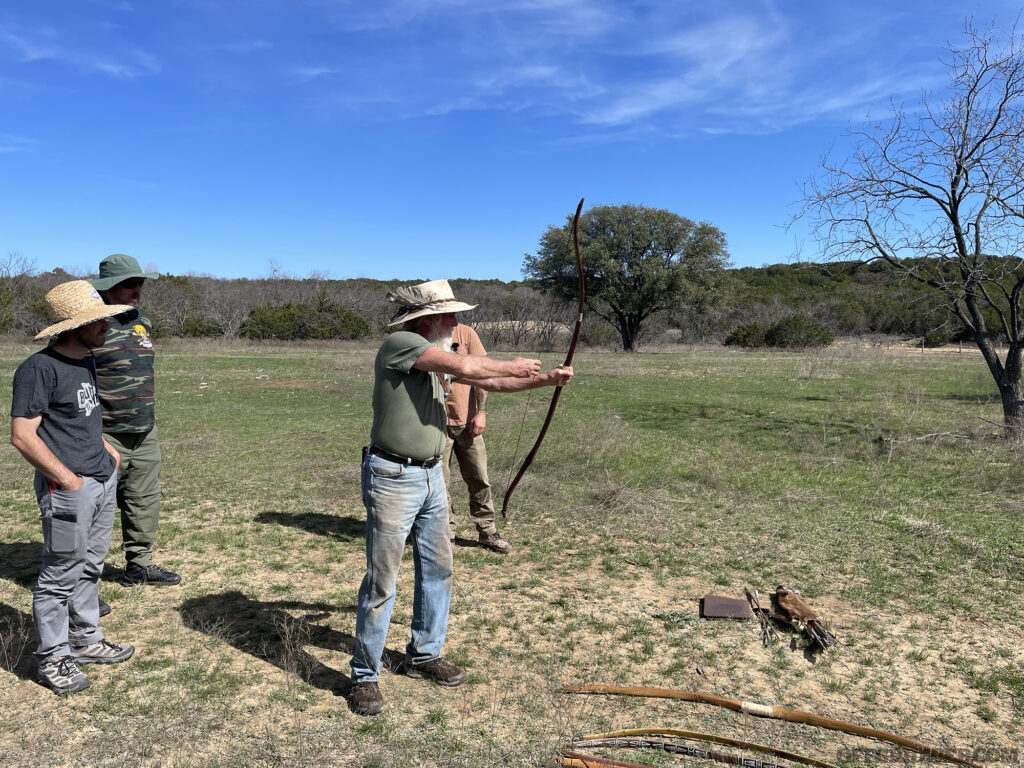
Above: Before a bow can be made, the draw length of the individual user must be determined.
Determining Draw Length
Every bow is a custom crafted creation, tailored to the individual who will wield it. As such, you must know the exact tension required as the string draws an arrow back. This isn't a trivial fact to be overlooked—it's the core of the craft, guiding the bow's optimal height and thickness. To master this, we took a completed bow and an arrow, etched with inch marks along its spine, to measure our natural draw length. It was similar to taking a measure of your reach. While there’s a myriad of opinions on the ideal length of a traditional bow, for our purposes, we settled on a simple method. We measured how far we could comfortably draw the arrow back. It's a technique that’s less about numbers and more about feeling, finding that sweet spot where the bow feels like an extension of your own body.
Carving the Staff
Figuring out the perfect length for the bow was just the start. Next, we began to carve the Osage orange, carefully coaxing it into the silhouette of a traditional Cherokee bow. One sage bit of guidance we got was from one of our fellow tribesmen was, “Carve away anything that isn't a bow.” Sounded cryptic at first, but it was spot on. Traditionally, one might have used stone tools for this delicate process. We were lucky enough to have draw knives and rasps on hand. But even with these modern conveniences, the task was a marathon. With each shave of wood, we balanced on a knives edge. Too much left, and the bow wouldn't bend, too little, and you'd hear the heartbreaking crack of failure. Sun dipping low, the first day's end found us still chipping away, not quite there yet.
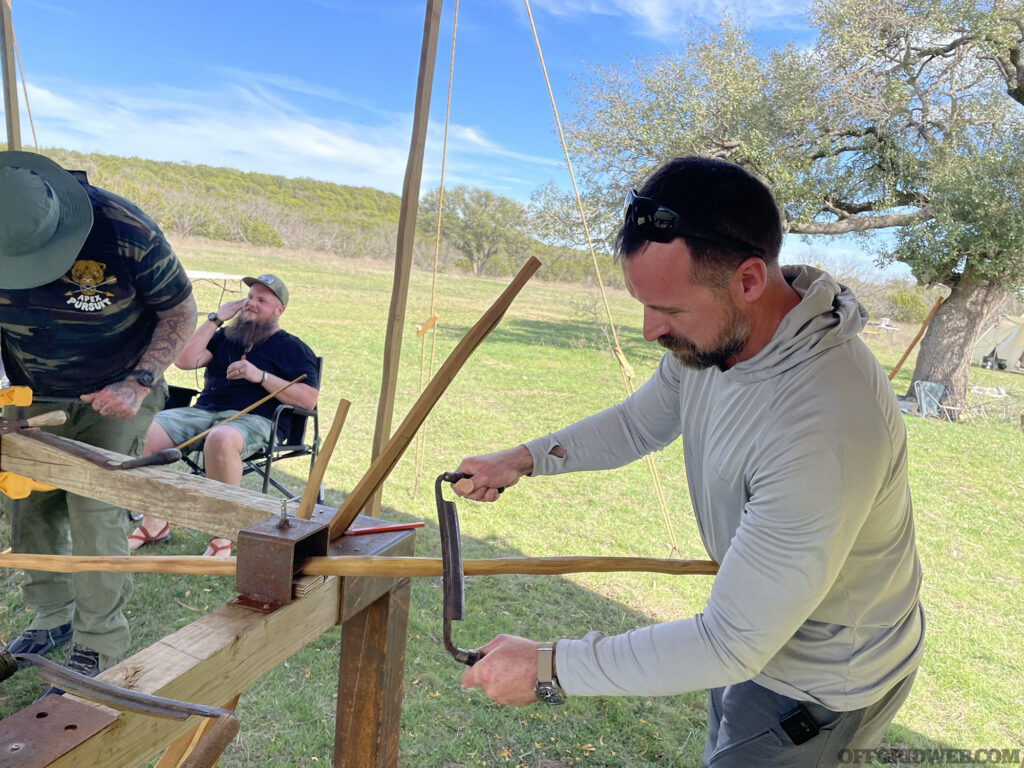
Above: With a bow held in place, a draw knife is used to remove would layer by layer until it becomes flexible enough to bend.
The second day's light ushered in an even finer dance with detail. As the bow's shape homed in on perfection, the coarse tools were traded for cabinet scrapers and sandpaper. Every so often, Phillip would put our progress to the test on his trusty tillering jig—our efforts being put to the ultimate stress test. It things did not appear quite right, back we'd go, scraping and smoothing. Each trial was a pulse-quickening moment, wondering if our creation would hold or shatter. But the seasoned Osage orange, tough as nails, didn't let us down. We kept on, tillering and sanding, painstakingly inching towards a bow that felt just right in our hands, tailored to our own pull and power.
Stringing the Bow
No bow can launch arrows unless matched with a string. Our forebears crafted bows with sinew, braided into lengths sufficient for strings—meaning they meticulously removed strips from sizeable beasts or intertwined shorter lengths, hoping the intense strain wouldn't snap or untangle the braid. Today, for ease and security, we employ a cord called B-50. This synthetic rope boasts remarkable tensile strength and is favored for crafting traditional bowstrings.
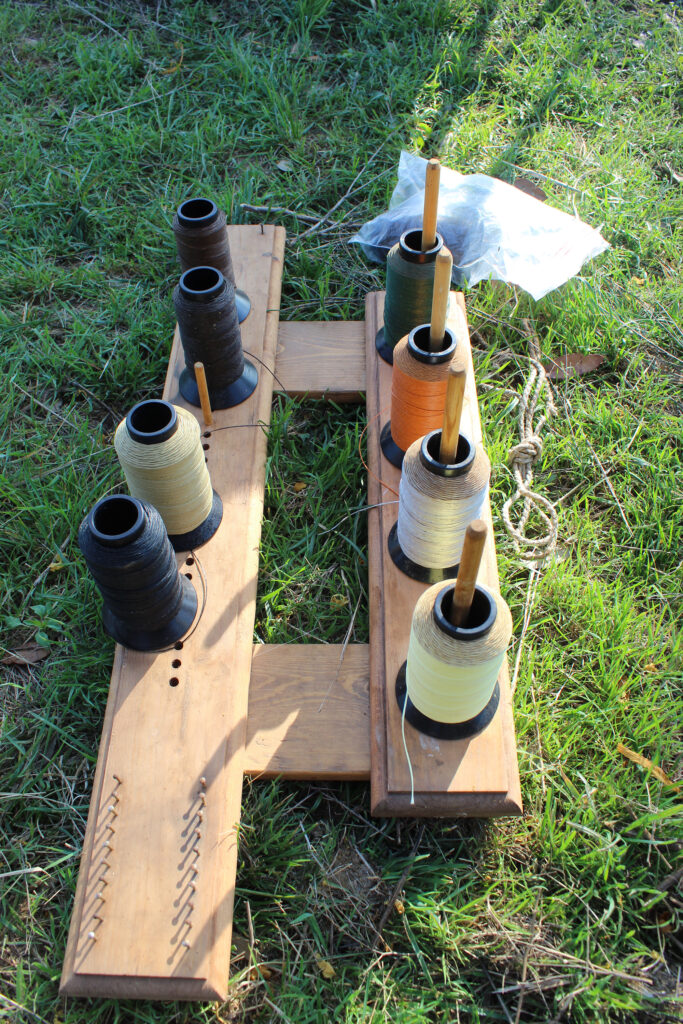
Above: B50 cordate is use for making bowstrings and comes in a variety of colors.
To fashion a string of proper girth, we interlace six strands each of two colors (totaling twelve strands) employing the reverse-wrap technique. One extremity is woven into a loop secured by notches at the bow's end. The opposite extremity is tied by hand, permitting adjustments to the string's span according to the chosen draw length and tension. For some, this braiding posed a significant test, while others, graced with nimble fingers, did it with less trouble. Fortunately, as members of a tribe, we could solicit assistance from the adept in exchange for aiding in tasks like bow contouring. This collaboration sped our progress beyond solitary efforts.
Crafting Arrows
Various materials can make a decent arrow shaft. Phillip notes the Cherokee preference for river cane, but we used bamboo tomato stakes from a nearby garden shop as a handy substitute. A suitable arrow shaft can be any material with the right diameter and either naturally straight or adjustable to be straight. We each scouted five or six straightish pieces, then gathered by the camp's central fire to refine their alignment.

Above: Sighting along the length of the bamboo reveals where the troublesome bends and curves are located.
Peering down the bamboo length, its bends and twists become apparent. Brief exposure to the fire's warmth softens the fibers, opening a short window of time to coax the shaft straight, easing out curves. It's a delicate balance—enough force to ensure it sets straight once cool, but not so much it snaps. Occasionally, bamboo with preexisting flaws would crack, despite our caution. Phillip reassured us, it's better for flaws to reveal themselves now, rather than during a high-tension launch from a bow.

Above: Using heat from a fire loosens bamboo fibers just enough to make it slightly more bendy, making it easier to straighten.
With our shafts straight, we addressed the bamboo's nodal bulges. Using rasps and sandpaper, we worked each one down to achieve uniform diameter end-to-end. Phillip reminded us that in a more primitive setting, this step would involve coarse stones and significantly more elbow grease.
Cherokee Fletching
Feathers are essential for stabilizing an arrow in flight. Contemporary arrows often sport two or three fins crafted from a slender polymer. For our projectiles, we've selected a pair of feathers, either turkey or goose, flanking the shaft. These quills must be sculpted to synergize, ensuring peak aerodynamic stability. Their silhouette typically mirrors that of a rocket fin yet can be tailored to the archer's liking. While many opt for scissors to carve the desired profile, the application of heat via a heated rock or blade can sculpt the feathers just as well.
To secure the feathers, we employ dampened sinew strands interlaced with adhesive—no intricate knotwork necessary. Phillip sheds light on the traditional concoction and application of hide glue for such tasks. However, our modern shortcut involves swift-setting wood glue. Once set, the fletching is remarkably rigid, resisting any attempt to dislodge it with sheer force.
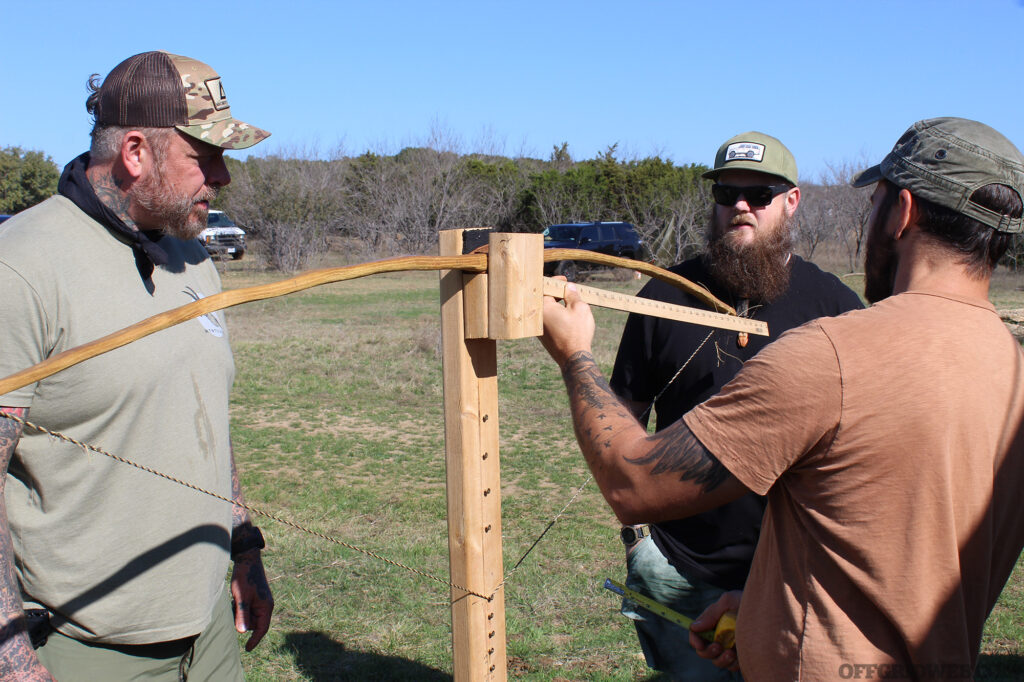
Above: Tillering is the process of adjusting how much each arm of the bow bends. By using a tillering jig like the one shown above, the curvature can be measured and adjusted.
As for the arrow's leading segment, we've calibrated it to be weight-forward by embedding weights within the bamboo's inner circumference. Phillip imparts wisdom on the use of sand or clay for weight, enhancing the arrow's impact and in-flight stability. In our case, to maintain momentum in our workshop and to ensure a forceful impact, we substitute sand or clay with metallic rods, sparing us the laborious task of maneuvering granular or sticky substances into the bamboo's narrow bore.
Gathering a bundle of our straightest, and best fletched arrows, we migrate toward the range for an impromptu test of precision. Our target is a rustic round hay bale, its center marked by a crimson bullseye. This venture doubles as a drill for bow stringing, a mildly cumbersome skill to master given the osage staves' reluctance to bend. Each of us are amazed at how powerful our hand-made creations are at this point, easily comparable to a modern traditional-style long bow.
A brief period elapses before the erratic flyers—victims of imperfect straightening or feathers—are singled out, leaving behind those arrows that reach the bullseye's vicinity with remarkable consistency. For a few among us, a pair of trusty shafts suffice. Yet for others, it presents an opportunity to tweak a nudge to the feathers or a twist to the spine. Those deemed true are meticulously segregated, ready for the progression to the next stage.
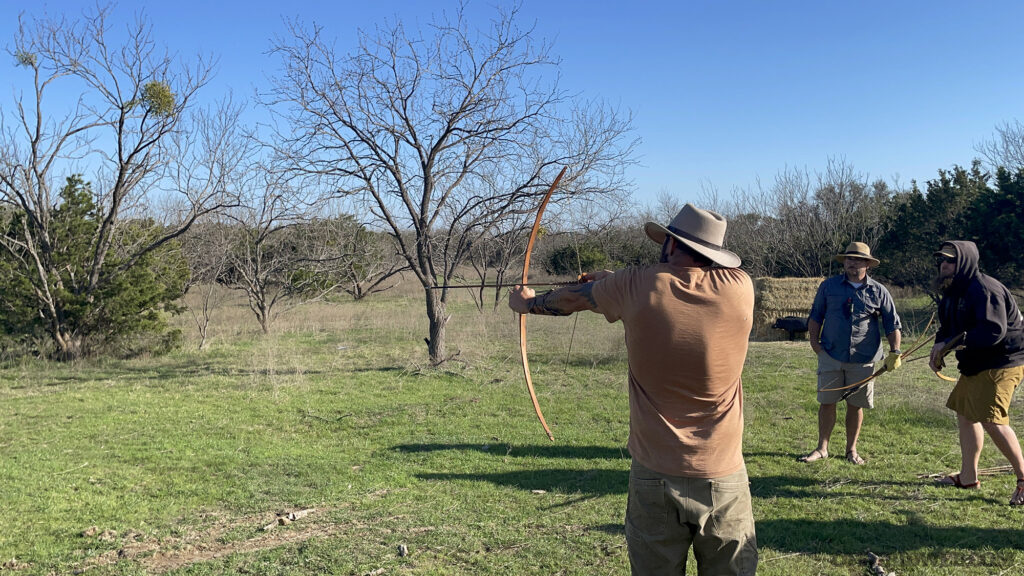
Above: Once a bow has been tillered and strung, its first field test is performed with a reliable practice arrow.
Arrowheads
Four days elapsed, and though we've toiled from the first light to dusk (a few of us even honing our archery in the pitch black, guided by headlamps), a significant challenge still looms. We aim to craft an arrowhead, primitive yet sharp enough to pierce the tough skin of a bison in its prime. Phillip imparts to us the art of stone knapping, a technique crucial to our forebearers.
Stone knapping is an expertise that demands years to master, and the prospect of acquiring enough proficiency to successfully produce an arrowhead within a single day is nothing short of intimidating. However, Phillip, alongside tribe members seasoned in knapping, delivers an exceptional introduction to the fundamentals. We're shown how strategic strikes create ripples in the rock's crystalline lattice, splitting off smaller fragments from the larger mass. Certain stones yield better results, and for our lesson, we select from a spectrum of obsidian, chert, and even glass bottle bases.
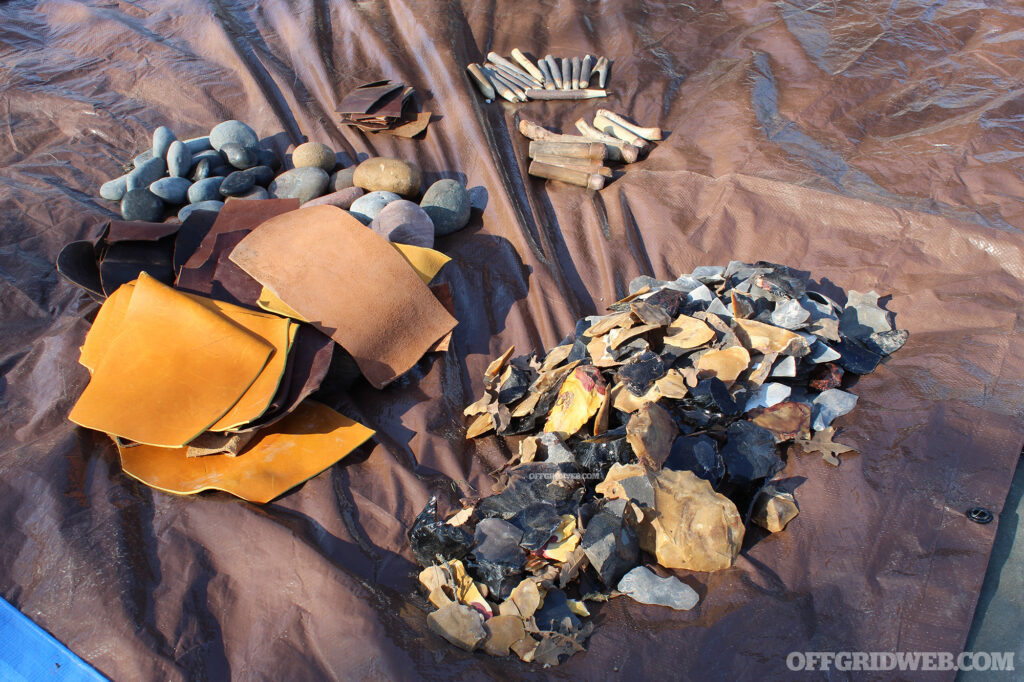
Above: A wide variety of tools and materials was provided so that each student could find what works best for them.
With shards in hand, we undertake the painstaking task of whittling them down to arrowheads, sliver by sliver. The implements are aptly named for their purpose—a ‘flaker', tipped with copper and similar in profile to the head of a marker, is for chipping away precise fragments. ‘Boppers', copper-domed ends fixed on dowels, serve to detach heftier sections and smooth out jagged rims. A robust slab of hide safeguards our legs, serving as a workbench for this delicate operation. Mastery of knapping is a gradual ascent which exceeds our limited time frame, yet under Phillip's and our skilled companions' tutelage, we edge closer to fashioning something that echoes the silhouette of an arrowhead.
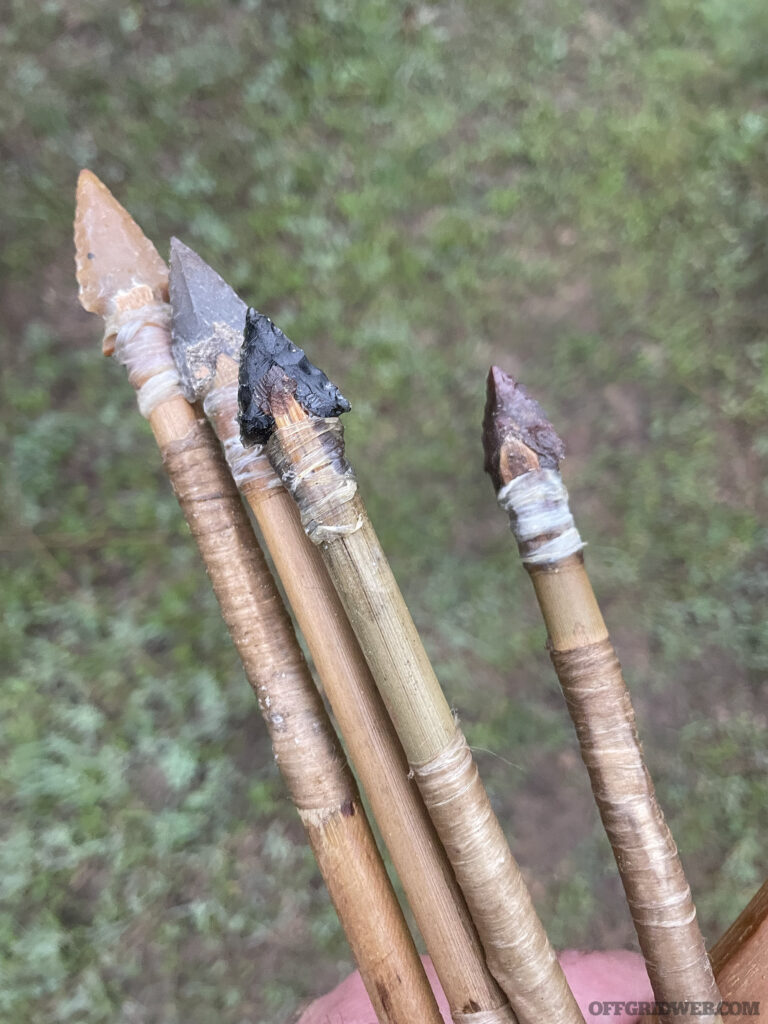
Above: Finished arrowheads are attached to the straightes and most reliable of the prepared arrow shafts.
To render arrows lethal for felling a formidable bison, arrowheads need to be attached firmly to their shafts. This is accomplished by concocting heated pine pitch—a blend of pine resin blended with the fibrous droppings of deer—within stone vessels positioned adjacent to a fire. Render the pitch too hot, it is prone to bursting into flame since its flashpoint is low. A recess is meticulously chiseled into the shaft, precisely sized to accommodate the arrowhead's base, and the heated pitch is used as an adhesive to secure the arrowhead in its niche. Afterwards, a concoction of wood glue and sinew is utilized to lash the arrowhead firmly, guaranteeing its integrity upon discharge from the bow. With the assembly of arrows and the stringing of bows, a solitary step remained: to track and bring down the colossal quarry.
Hunting a Bison
As the evening unfolded before the anticipated day of the hunt, our campfire glowed, a testament to a week's diligent efforts. We exchanged hearty praise over each other’s bowmanship and eagerly speculated about the forthcoming pursuit. Our conversations stretched into the night, our eyes drawn upward as a shroud of clouds covered the stars, while the distant rumble of an approaching thunderstorm provided a backdrop to our gathering. Hunkering down for the night, we all fell asleep in our tents thinking about the next day, wondering how it would play out.

Above: Students stage and prepare their firing positions at a potential ambush site while Phillip watches for the quarry.
Post-storm, a mist had claimed our encampment, kicking off hunting day draped in overcast skies and the promise of residual showers. Prior to setting out for the territory where we would embark on our quest, Phillip gathered us together, initiating a ceremonial pre-hunt observance. Arrayed in a crescent formation, the moment to express reverence for the existence we were set to claim was upon us. In nature, an animal such as the bison might meet a grisly fate, falling prey to the savagery of the food chain, often only after a battle with the infirmities that come with old age, sickness, or injury. On this day, we aimed to salute its essence, bringing its life to a swift and compassionate end. Our ritual concluded with the cleansing aroma of juniper and the purifying essence of sage, a ritual to obscure our presence from the keen senses of our quarry.

Above: The shrewd bison cleverly utilized a herd of cattle as protection and early warning.
As luck would have it, the hunt did not go quite as expected. Bison are incredibly intelligent, clever animals, and the one we were hunting made us work demandingly hard for it. The hunt itself lasted a day and half, despite our tribe of eight (and the rancher who owned the property) tenaciously going after it. Our quarry defied our expectations at every turn. It never set a pattern, never reacted the way we thought it would, and never maneuvered to where we were trying to drive it. Over the course of the hunt, we watched it jump over six-foot high fences, leap over cattle traps, and even use cattle herds as cover. In the open, it never let us get close enough to take a shot. Concealed in woodland, it tread silently on the forest floor, gliding through dense underbrush that impeded us. Sometimes it seemed to vanish into the ether, forcing us to regroup, invent new strategies, and begin tracking all over again.
Eventually, after much frustration and many miles of active tracking, stalking, and hunting, our tribe maneuvered it into a position where it could be safely harvested. For some it was a joyous relief, for others it was a poignantly emotional end. But no matter how everyone felt upon the culmination of our efforts, we were all proud of the work we had put into in, and grateful to have gone through the experience with such an amazing group of people.
Final Thoughts
Curiosity often sparks when pondering the bare-bones lifestyle of living directly from the earth. We might lose ourselves in films like ‘Dances with Wolves' or the historical narratives of trailblazers like Lewis and Clark. Imagining ourselves in their stead, it might seem feasible to emulate their existence. However, the theatre of the mind is vastly different from tangible existence, and the cultivation of skills that our ancestors mastered with apparent ease demands both relentless dedication and time. Our time spent with Primitive Wilderness Survival is testament to this. We took many shortcuts by substituting stone tools with steel, and other modern amenities, otherwise the course could have easily taken twice as long.
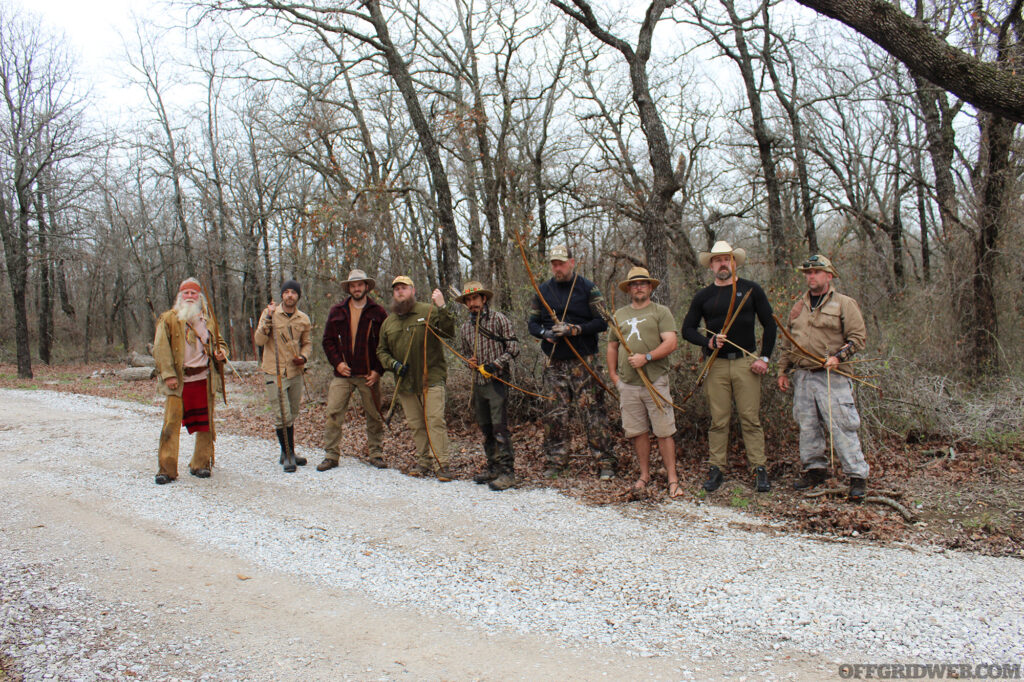
Above: Being a member of a tribe has numerous advantages, capable of performing tasks faster and with greater efficiency than a single individual could ever hope to accomplish alone.
Grasping the extent of challenges our distant predecessors endured to thrive solely on nature's offerings is not accurately gleaned from the passive acts of reading, or watching tales unfold on screen. I confess, my initial assumptions about the labor involved were naive until I engaged in the actual process of fashioning a hunting implement and the subsequent endeavor to procure game with it. My enlightening journey alongside our tribe, and Primitive Wilderness Survival expert instructor Phillip Liebel, illuminated the astonishing resourcefulness intrinsic to humanity and the formidable force of collective minds striving toward a shared objective.
To answer the question of whether living solely off the land is possible, the answer is a resounding ‘yes’. Yet the difference between surviving to thriving pivots on whether one chooses solitude, or the fellowship of a tribe of like-minded individuals, unified by purpose. Immersing oneself in the study of primitive skills reveals just how important and intertwined humanity is with another, and during these tumultuous times, it is worth rediscovering that important truth.
About Primitive Wilderness Survival
Interested in getting some hands on experience learning primitive self-reliance skills? Check out Phillips upcoming courses at Primitive Wilderness Survival
Read More
Subscribe to Recoil Offgrid's free newsletter for more content like this.
The post Blood and Thunder: Reviving Primitive Wilderness Survival Skills appeared first on RECOIL OFFGRID.
https://www.offgridweb.com/preparation/blood-and-thunder-reviving-primitive-wilderness-survival-skills/
 CampingSurvivalistHuntingFishingExploringHikingPrivacy PolicyTerms And Conditions
CampingSurvivalistHuntingFishingExploringHikingPrivacy PolicyTerms And Conditions
